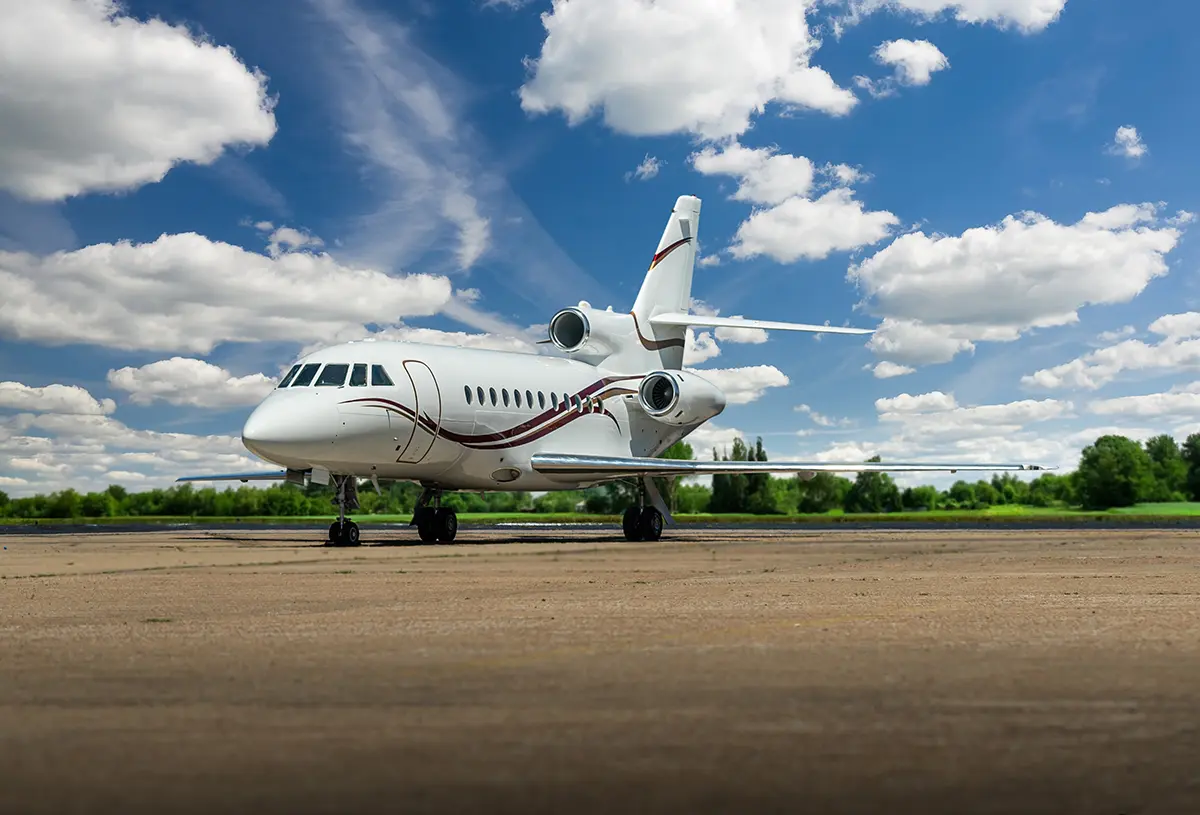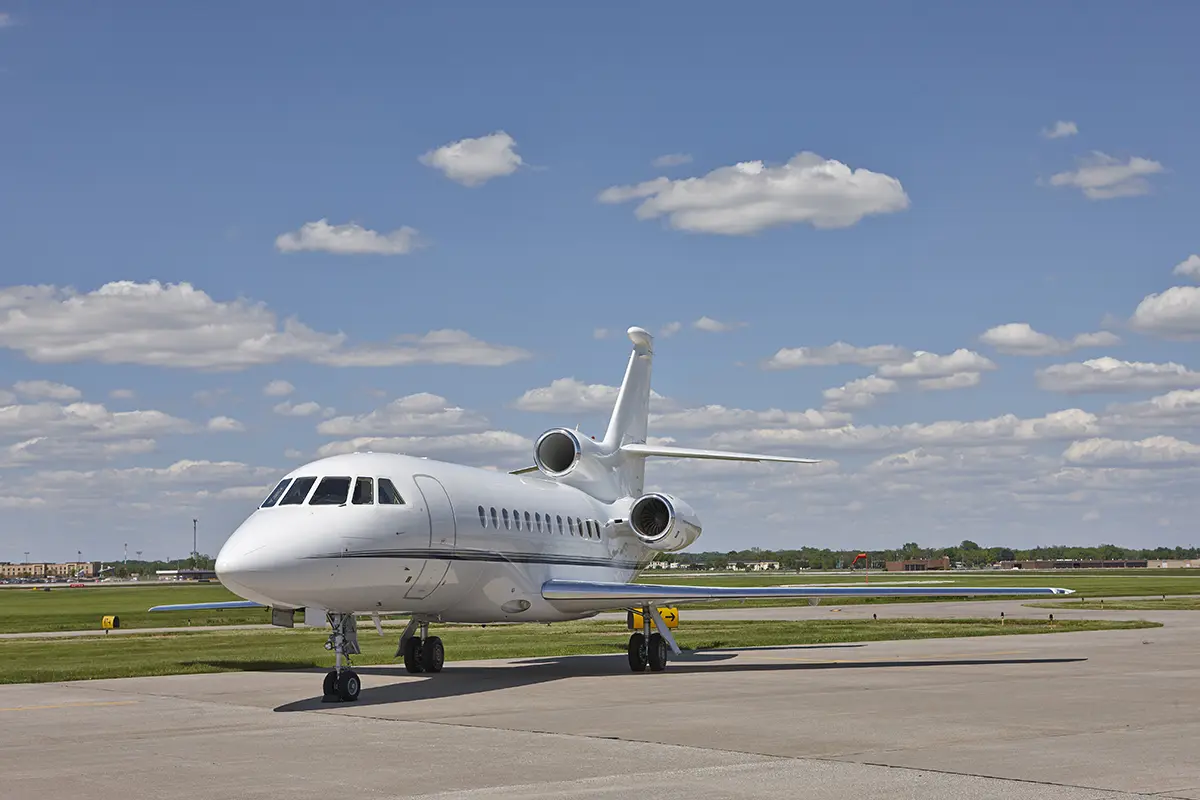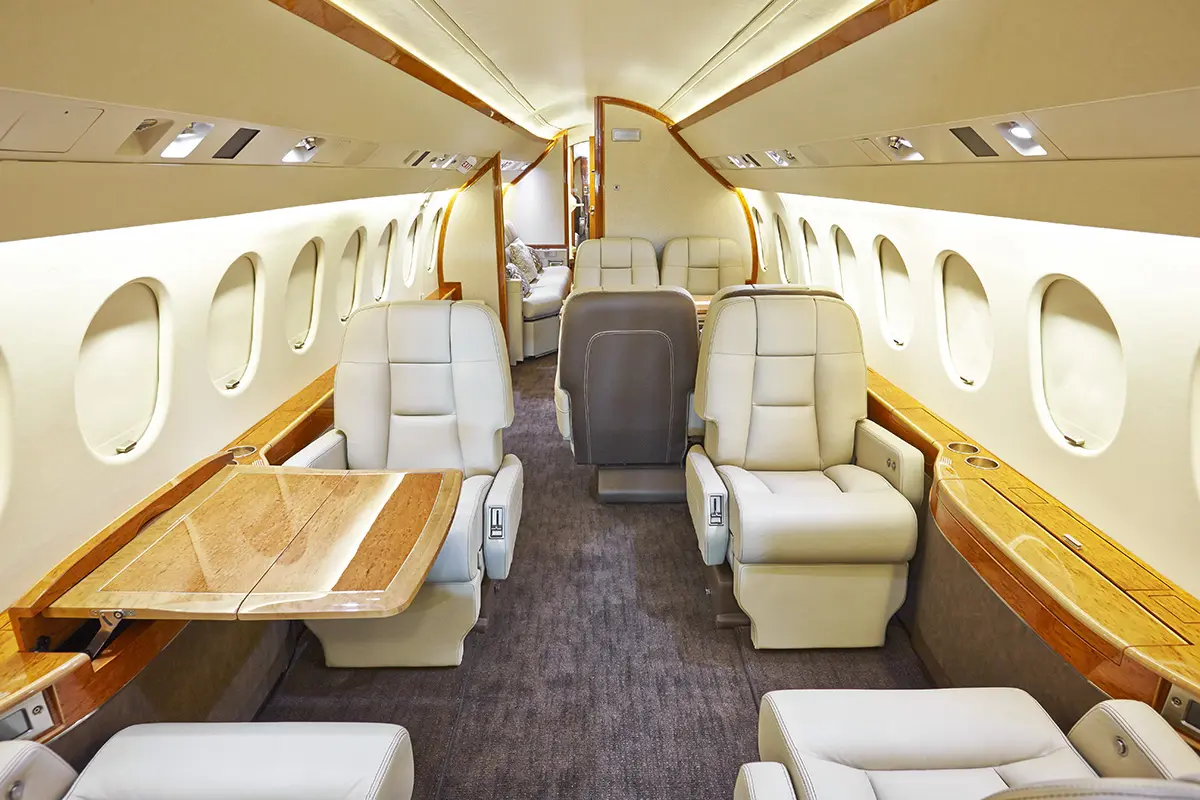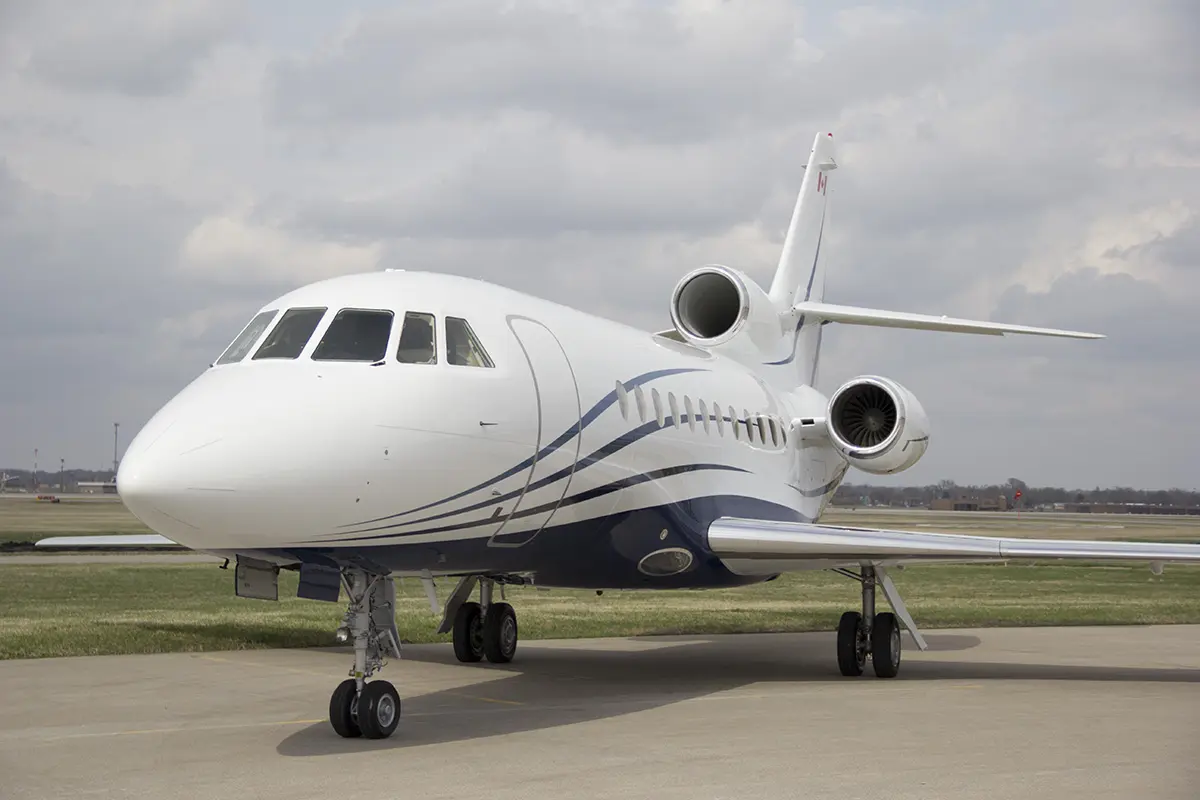
Dassault’s Falcon 900 series of aircraft delivers reliable, efficient performance in the large business jet category. The Falcon 900 models have held their place in the market for nearly four decades because they are a reliable, efficient, and adaptable series that elegantly meets the modern business traveler’s needs.
These workhorses are the product of more than a century of aviation design and production. Contrary to this stolid endurance, Dassault Aviation’s history is a swashbuckling adventure, beginning virtually at the dawn of the aviation industry itself.[1] The company and its founder were at the epicenter of both World Wars; the first enabled their success, and the second nearly killed them both. The Dassault brand’s defining resilience in the face of adversity ensures its continuing success in the modern business jet market.
Marcel Bloch was born in 1892 in Paris, France, and was fascinated with flying as soon as he saw the first plane circle the Eiffel Tower. He earned a degree in aeronautical engineering; when he began his military service, he was assigned to an aeronautics laboratory to support the French war effort. In 1916, he designed a new propeller called “l’Éclair” (“Lightning”); the design was one of just three that the French government chose for use in its fighter planes. Partnering with some friends, Bloch began his own aircraft manufacturing company. As the war drew to a close, however, the French government canceled its orders for new military aircraft, forcing Bloch to shutter the business.
By 1928, however, aviation had captured civilian industries’ attention, and the French government decided to expand its military aviation capabilities. Charles Lindbergh’s transatlantic flight inspired Bloch to return to aviation production, and he submitted a proposal to the French government for a three-engine mail delivery plane. Over the next decade, Bloch’s new business designed and built hundreds of combat aircraft for the French army, including single, double, and tri-engine transport planes, fighters, light bombers, and ground attack planes. In the 1930s, he also began to design and build passenger airliners. In addition to his technological innovations, Bloch was a pioneer for workers’ rights and working conditions, providing his workers with paid vacation as early as 1935.
Bloch’s factories, along with the rest of France’s aviation industry, were nationalized in 1936, and Bloch was appointed managing director of the government aviation department. In 1940, however, he was imprisoned by the Vichy government (allied with the German Nazi government). Based on his refusal to cooperate with the Nazis and his Jewish heritage, he was sent to the Buchenwald concentration camp. Despite being tortured, beaten, and kept in solitary confinement, Bloch survived, and he returned immediately to aviation production. After the war, he changed his last name to “Dassault,” an alias his brother had used while fighting with the French Resistance.

Dassault’s aviation production flourished in the post-war industrial boom, bolstered by the French government’s support of the industry. His company produced more than 20 different aircraft types, developed numerous prototypes, and innovated countless new technologies. In 1954, it established a dedicated electronics division, which began developing airborne radars, seeker heads for air-to-air missiles, navigation technology, and other military technology. Besides designing and building many successful military aircraft models, the company also produced civilian aircraft for business transport.
In 1963, Charles Lindbergh visited Dassault on behalf of Pan American World Airways. The American company subsequently contracted with Dassault to distribute its Mystère 20 aircraft through PanAm’s new corporate jet aircraft sales division. By 1966, after some redesigns, the model was rechristened the Falcon 20. Its immediate success and popularity would lead to the development of a family of corporate “bizjets” that today includes six different Falcon models.
Dassault has always been a pioneer and industry leader in electronic systems, including radar, hydraulic power assistance, and fly-by-wire control systems. Because of these innovations, the company developed a reputation for safety and ease of handling. As part of its emphasis on constant innovation and focus on R&D, the company invested early in computer-aided design (CAD). Its pioneering software for three-dimensional design, CATIA (computer-aided three-dimensional interactive application), is now widely used by many aviation manufacturing companies and numerous other industries, including architecture and product design.

The Falcon series of business jets encompasses a range of six aircraft, capable of flying from 3,350 nm (6,205 km) to 6,450 nm (11,945 km), which serve a broad range of corporate travel needs. Multi-mission Falcons can also carry out military and public service missions: surveillance, maritime response or patrol, medical evacuation, cargo, etc.
The original Falcon 900 first flew in 1984, and its family now includes the Falcon 900B, Falcon 900C, Falcon 900EX, Falcon 900C, Falcon 900EX EASy, Falcon 900DX, and Falcon 900LX versions. Dassault also designed and designated specialty models for the Japanese Coast Guard and Italian military operations. The Falcon 900EX EASy 900EX, named for its Enhanced Avionics System (EASy), boasted a T-shape configuration of cutting-edge Honeywell Primus Epic avionics and path-based flight display. The Falcon 900LX, the current production model, is notable for its high-Mach blended winglets (which are also certified for the entire Falcon 900 series as a retrofit kit) and its impressive range of 4,750 nm (8,800 km)
Its competitors in the large-size transcontinental corporate jet category include the Bombardier Challenger 605, the Embraer Legacy 450, 500, 600, and 650, the Praetor 500/600, and the Gulfstream G450. The Falcon models are the only business jets to use a three-engine design, with a center fin-mounted engine between the two engines flanking the rear fuselage. The Falcon 900B models sport three 21.1kN (4750lb) AlliedSignal TFE731-5BRs, while the Falcon 900EX upgrades to three 22.3kN (5000lb) TFE731-60 engines.[2]
Despite the tri-engine design, all of the Falcon 900 series jets are remarkably fuel-efficient. They are substantially lighter than other large-cabin, long-range business jets due to their streamlined design and lightweight composite materials. (For comparison, the Falcon 900EX weighs in at 48,300 lb. maximum takeoff weight, compared to the Gulfstream G450’s beefy 74,600 lb.)[3]
The Falcons’ aerodynamic efficiency and light weight allow them to use (and thus carry) less fuel. Less fuel use translates to lower operating costs and reduced emissions, which makes it more environmentally responsible than many of its competitors. Falcon 900EX and Falcon 900EX EASy each burn 282 gallons per hour (GPH) of JET A, which is 165 GPH (36.9%) less fuel than the Gulfstream G450 (447 GPH).[4]
The Falcon 900B offers a maximum cruising speed of 927km/h (500kt), an economical cruising speed of Mach 0.75, and a maximum certificated altitude of 51,000ft. Its range with eight passengers and reserves at Mach 0.80 is 7150km (3860nm); with the same specifications, the Falcon 900EX expanded this range to 8020km (4330nm).[5] The newest model, Falcon 900LX, has a maximum range of 8800 km (4750 nm). In real-world terms, this means an even more impressive international range: Shanghai to Moscow, Mumbai to London City Airport, or Chicago to Zurich.[6]
Another notable advantage of the Falcon 900 craft is that they can take off and land at lower speeds than their competitors—10-15 knots slower than comparable jets.[7] Slower landings increase safety as well as providing greater access to small airports, even at higher altitudes. (One notable example: the Falcon 900 is the only large-cabin business jet that is FAA certified to use London City airport, located in the heart of the city.) This advantage is due to the Falcon 900’s innovative design, which minimizes drag and incorporates numerous high lift features in the wings that are not found on other business jets. The runway requirement for the Falcon 900LX is 5,215 feet; for comparison, the Embraer Legacy 650 requires 5,804.[8]
Additionally, the Falcon 900s can take off and land with full fuel tanks; this enables travelers to more conveniently and flexibly plan multiple stops into their itinerary.[9]

The modern Falcon 900 series aircraft offers sleek, stylish, fully customizable cabins reminiscent of BMW interiors. Electronics packages offer personalized entertainment, communications, and business technology at passengers’ fingertips. They are also equipped with (or can be easily upgraded to) the latest connectivity equipment, including high-speed Internet connection, allowing passengers to access the Internet or conduct video conferences just like in the office.
The Dassault Falcon 900LX has a flat floor cabin, with more height and width than the Legacy 650, although since it is shorter than the Legacy 650, it offers less overall cabin volume (1,270 cu. ft. compared to 1,656cu.ft).[10] A standard cabin configuration offers four club chairs, a four-seat conference table, and two aft divans, which can be folded into a lay-flat sleeping area. A particularly thoughtful touch is an available privacy partition between the aft and main cabin areas.
Configurations are available for between 8 and 19 passengers, with a typical layout seating 10-12. Falcon 900 series models are highly customizable, with unusual options like 6-person conference seating, lay-flat reclining club chairs, an optional second, forward lavatory, and an expanded self-serve galley. The Falcon 900LX has 127 cubic feet of internal baggage space, which can be accessed both in-flight through the aft lavatory and externally from the ground.
For flight crews, the luxurious touches include innovative avionics and intuitive controls. Falcons benefit from the legacy and technological innovations of combat aircraft: cockpit, digital flight control system, head-up display, flight quality, aerodynamics, and much more. The revolutionary FalconEye Combined Vision System is the first HUD (heads-up display) that combines synthetic, database-driven terrain mapping and actual thermal and low-light camera images into a single view. This military-grade technology system improves situational awareness for flight crews in all conditions of operation and increases safety.[11] The Falcon 900 series’ consistency, reliability, and ease of operation have won these aircraft the admiration of pilots since the very beginning, and the upgraded avionics only enhance that reputation.[12]

Dassault has produced more than 500 of the series 900 Falcons since the original model rolled off the production line in 1986. Because of their excellent design, construction, and technology, they hold their value well and are easily upgraded and retrofitted.
Blended winglets from Aviation Partners are an approved upgrade for all Falcon 900 models.[13] The sleek additions cost approximately $750,000 and take about four weeks to install, but they can increase range up to 5 percent at high-speed cruise and 7 percent at long-range cruise speeds, and they allow a faster, more fuel-efficient climb to altitude.[14] Buying an older Falcon 900 model and upgrading it with winglets, new interiors, and state-of-the-art avionics upgrades can be a cost-effective way to own a very well-appointed, customized aircraft for $12 million to $13 million.[15] Installing an acoustic-blanket sound dampening can reduce cabin noise by three to seven decibels in flight, and available adjustable color/intensity LED lighting can help reduce passenger fatigue.
Dassault’s service program includes three heavy service centers for all levels of scheduled maintenance, airframe and engine maintenance, paintwork, interior modifications, avionics installation, and upgrade. These centers are located in Little Rock, Arkansas, Wilmington, Delaware, and Le Bourget, France. There is also a major service center in Reno, Nevada, which can provide all levels of scheduled maintenance and engine/APU line maintenance services, and a line service center in Sorocaba, Brazil, that is capable of full A inspection, avionics upgrade, and engine/APU line maintenance. All Dassault facilities offer 24/7 AOG support, unscheduled maintenance, and troubleshooting service.
Seven satellite service stations (Van Nuys, California; St. Louis, Missouri; West Palm Beach, Florida; London, England; Rome, Italy; Moscow, Russia; Nice, France) are capable of troubleshooting and unscheduled maintenance. Demonstrating the company’s commitment to customer support, it deploys two company-owned Falcon 900s as rapid-response aircraft to transport Dassault Go Teams of technicians, parts, and tools and ferry customers to their destinations while their aircraft is being serviced. These two aircraft are based in Teterboro, New Jersey, and Le Bourget, France.

Purchasing a large-cabin business jet, like those in the Dassault Falcon 900 series, can allow your business to reduce or eliminate travel on commercial airlines. This not only saves time and money but can also reduce potential exposure to health hazards, security delays, and other hassles. The versatility and excellent airport performance of the Falcon 900s can also help cut down on vehicular travel since these planes can fly to locations that may not have commercial airline access. Being in control of your business travel, rather than subject to the schedules and requirements of commercial travel, can save countless hours of wasted time and money. Owning your own business jet also increases your travel comfort, allowing you to arrive at your destination refreshed and ready to go. With upgraded communications and connectivity, having a business jet is essentially having a fully-equipped mobile office.
Businesses can generally depreciate aircraft used for qualified business purposes, including Part 91 business use flights, under a modified accelerated cost recovery system over a period of five years. Businesses may choose, instead, to use the alternative depreciation system with a six-year recovery period. (Owners should be aware, however, that using the aircraft for non-business purposes in addition to business-related travel can impact the allowable amount you can deduct yearly for depreciation; you should consult with a tax professional for more specific information.) Additionally, the 2017 Tax Cuts & Jobs Act allows qualified individuals and businesses to deduct up to 100 percent of the cost of a new or used aircraft purchased after September 27, 2017, and placed into service before January 1, 2023. These incentives increase the benefits and cost savings of buying a business jet.
If you are interested in learning more about purchasing one of the Falcon 900 family of jets, contact Elliot Jets today. We can help you find the perfect aircraft for your company’s needs, locate the best model at the right price, and customize your purchase with the stylish and technological upgrades that are right for your business.
[1] “About Us.” www.dassault-aviation.com. https://www.dassault-aviation.com/en/group/about-us/civil-and-military-aircraft/
[2] “Dassault Falcon 900.” Airliners.com.
[3] Chase, Mike. “Aircraft Comparative Analysis – Dassault Falcon 900EX/EX EASy. » AvBuyer.com. 1 May 2014. Accessed 31 Mar 2021.
[4] Chase, Mike. “Aircraft Comparative Analysis – Dassault Falcon 900EX/EX EASy. » AvBuyer.com. 1 May 2014. Accessed 31 Mar 2021.
[5] Id.
[6] “Range Map.” Dassault Falcon.com. Accessed 1 Apr 2021.
[7] Dassault Falcon. (2012, Dec 20). Falcon Airport Performance. [Video.] YouTube. https://www.youtube.com/watch?v=2HvrZLoyo44
[8] Chase, Mike. “Jet Comparison: Dassault Falcon 900LX vs Embraer Legacy 650.” AvBuyer.com. 1 Sep 2019. Accessed 31 Mar 2021.
[9] Dassault Falcon. (2012, Dec 20). Falcon Airport Performance. [Video.] YouTube. https://www.youtube.com/watch?v=2HvrZLoyo44
[10] Chase, Mike. “Jet Comparison: Dassault Falcon 900LX vs Embraer Legacy 650.” AvBuyer.com. 1 Sep 2019. Accessed 31 Mar 2021.
[11] “FalconEye.” DassaultFalcon.com. Accessed 1 Apr 2021.
[12] AvBuyer. (2019, May 16). The Insiders’ Guide Ep 7: Falcon 900EX EASy with Jim Word. [Video.] YouTube. https://www.youtube.com/watch?v=hvaDWUoj1ok&t=974s
[13] “API Blended Winglets ANAC Approved for Falcon 900 Series.” Aviation Partners, Inc. Aug 2017. Accessed 1 Apr 2021.
[14] Huber, Mark. “Dassault Falcon 900B.” Business Jet Traveler. Sep 2015. Accessed 1 Apr 2021.
[15] Id.